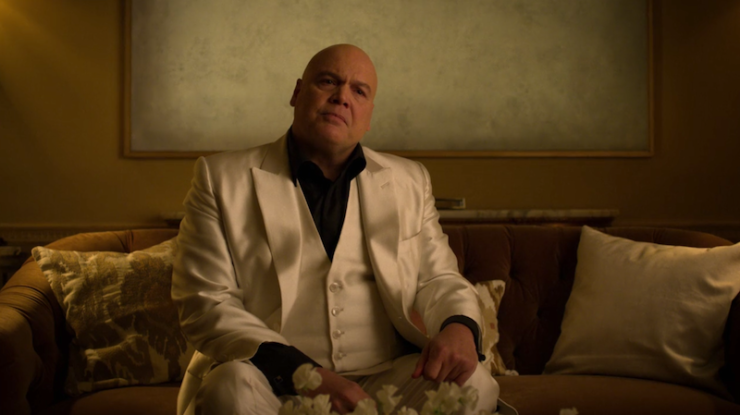Kingpin is one of Marvel’s best known villains for a reason; he is a mortal man who pits himself against superheroes and often succeeds, an indomitable figure that should never be crossed. His portrayal on Daredevil by Vincent D’Onofrio has only served to elevate the character’s stature—D’Onofrio has imbued Wilson Fisk with fury and purpose, but also with idiosyncrasies and vulnerabilities that enrich the viewer’s understanding of what it means to be a man who wants to shape the world through sheer brutality and might.
But he has no idea how to decorate an apartment.
Kingpin made his big comeback in the latest season of Daredevil, and the character work laid in his first season introduction bore out in some fascinating directions, tracking his long-game return to the New York City underworld. But perhaps the most integral of all these avenues was a clear indictment of his engagement with art. This is presented on two fronts—a general obsession with lavish living and his more focused obsession on “Rabbit in a Snowstorm,” a single painting that connects him to his lover Vanessa Marianna. In examining how Fisk relates to these things, we find a man bankrupt of creative conscience, a man therefore ignorant of art’s power and purpose. This ignorance is inextricably tied to his downfall and to his position as the series’ villain. The fact that Wilson Fisk is incapable of understanding art is tied to his moral vacancy, a signal of his lack of humanity.
When we meet Wilson Fisk in season 1, he is part of a criminal consortium, a man building his own little empire and pulling strings. He encounters Vanessa at the art gallery where she works, and their first conversation is about a painting called “Rabbit in a Snowstorm,” a large canvas covered in white gradients. Vanessa tells him that people often ask how they can charge so much money for such a seemingly simple work, and she explains that it’s not about the artist’s name or their skill, it’s about how the piece of art makes a person feel. Fisk counters that it makes him feel alone. He buys the painting and hangs it in the bedroom of his penthouse apartment, and we later learn that his attachment to the painting is representative of something far more sinister; it looks like the wall of the apartment where he lived as a boy. It is the same wall that his abusive father told him to fixate on while he was ordered to think about “the man you wanna be,” the same wall that he focused on once again after murdering his father by hitting him repeatedly in the back of the head with a hammer. Being reminded of that wall is not really about engaging with the piece of art itself—it’s about re-centering himself when beset by traumatic memories from his past.
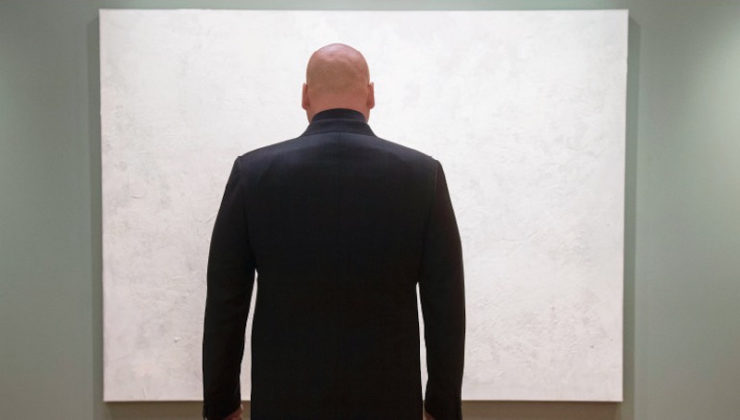
That penthouse is just one of many trappings of wealth and success that define Wilson Fisk’s life: expensive clothes and furnishings, fancy cars and employed drivers, the ability to dine at the finest restaurants and even to buy them out for a night whenever he wishes. But on his first date with Vanessa, he orders a bottle of wine, then tells her, “I don’t know much about wine. My assistant, he recommended it.” His assistant, James Wesley, is more than an employee—he is Fisk’s closest friend and confidante. He is also an arbiter of excellent taste, and well capable of divining what his employer needs often without being asked. It is probable that Wesley is responsible for the appearance of much of Fisk’s life, the quality of his wine and cars and suits, the precise knots of his bowties. Wesley’s careful guidance makes it appear that Wilson Fisk has opinions and tastes when he truly has very few: he has a wardrobe full of clothes, but selects the exact same colors to wear every day; he has a tray of fine cufflinks, but elects to wear his late father’s pair; he has a stocked state-of-the-art kitchen, but prefers to have the same, simple French omelet (Vanessa’s favorite) every day for breakfast. The one time he verbally expresses an excited opinion over something is when he tells Vanessa that the restaurant they are dining at has an excellent zuppa inglese, his favorite dessert from childhood, one that his beloved mother often made for him. Outside of that moment, he is a blank slate.
Vanessa seems to notice this, and once she has entered Wilson’s life, she begins to direct him toward different choices. Being an art curator, she has an eye for quality, creative expression, and as she tells Fisk after he orders the zuppa for them for dessert on that date, “It’s good to try new things.” She dusts off different suits in his closet for him to wear; she selects brand-new ones in colors he’s never worn before; she picks out a different pair of cufflinks in his tray so that he’s not constantly reminded of his monstrous father. It’s possible that Vanessa believes that she is helping him learn by exposing him new ideas and inviting new experiences. When she briefly meets Matt Murdock at her gallery, she tells him that “There is something very intimate in seeing art through another person’s eyes.” In the moment, she is speaking to Matt’s blindness, but it’s possible that she also believes Wilson is doing much the same through her.
Yet when Fisk meets Matt in that same encounter, and Vanessa tells him Matt is looking for advice from a man of taste, his reply is, “Well, that’s simple. Buy whatever the lady tells you.” It seems like flattery, but it also speaks to Wilson’s Fisk’s true outlook when it comes to art, style, and creativity—he outsources it in his life, first to Wesley, then to Vanessa.

This comes even clearer in Dardevil’s third season, as Wesley’s death and Fisk’s separation from Vanessa make it even more evident that he has no perspective when it comes to any form of art, be it paintings, architecture, fashion, food, or otherwise. After Fisk makes his deal with the FBI and ends up situated in the penthouse of a hotel that he covertly owns, he gets dispensation to furnish the apartment, obtain new clothes, and so on. He makes the same omelets for breakfast because they remind him of Vanessa. His tray of cufflinks is returned to him, but he only wears the pair she picked out for him. He hangs art on the walls, and obtains new furnishings—perhaps these are Vanessa’s old possessions? But the apartment is arranged in a jarring fashion, everything oddly slotted into place like someone was arranging a Tetris board rather than making choices about decoration.
Then Wilson Fisk dons his trademark white suit.
In the comics, the suit is synonymous with the Kingpin. It is his uniform, as much a part of his persona as any hero’s spandex. But the show recontextualizes that suit in more ways than one. To begin with, when Wilson Fisk met Vanessa Marianna, she was dressed in white, and it was her favored color for clothing. There’s more; on their second date, Vanessa told a story to him about a prince who hit on her while she was traveling with an art collection. The guy used a romantic though over-the-top line on her, but she slept with him anyway, and Fisk showed discomfort at the tale. When questioned about it, he admitted being upset because he wished he had used such a line on Vanessa when they had met. And the prince? He was wearing a white suit with an ascot. (Fisk remarks that the ascot sounds a bit too much, which is a nod to the comics iteration of Kingpin’s suit, which often does come with the flashier neckwear.)
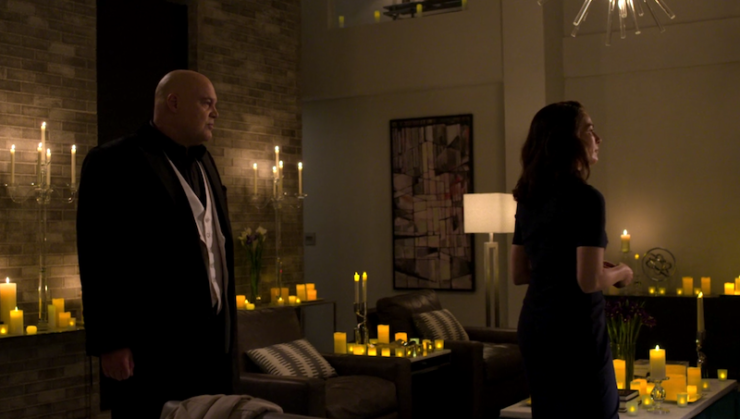
In the new penthouse apartment, the walk-in closet is literally lined with copy after copy of an identical white suit—rather than attempting to arrange a wardrobe suited to his tastes, a reflection of personal style showcasing any knowledge of fashion whatsoever, Fisk has chosen to don a color favored by the woman he loves. He chooses to wear that suit every single day so that whenever Vanessa is returned to the United States and they are reunited, he will be dressed as that suave prince was, wearing the cufflinks she selected. Fashion has long served humanity as a form of self-identification, a way of communicating things about ourselves to the world, and this is particularly easy to do when money is no object for a person, as is true in Fisk’s case. But here, there is no personal signature. The white suit isn’t a mark of Kingpin manifesting and coming into his own; it is further proof that Wilson Fisk has no opinions, thoughts, or relationship to art.
When Vanessa finally does arrive and Fisk introduces her to their new life in the hotel he purchased, he continues in this same vein, his opinion non-existent, his relationship to art more about ownership than any sort of attempt toward comprehension. When she walks into their penthouse, he says, “I don’t have your eye. But I hung them where I… guessed you would like them. We can move them, or buy other ones, whatever you like. I thought that you might want to curate a collection and display it throughout the hotel.” It’s complimentary, again, and while it’s nice that Wilson is enamored of Vanessa’s expertise, it’s still a matter of outsourcing. He allows her to know about art for him. He knows she would probably be pleased to curate her own art collection for the hotel, but that collection would still lend the place a pedigree that fits in perfectly with its three restaurants and proclaimed best spa in the city. It’s all about the appearance of class, wealth, and power, but Fisk himself doesn’t appear to appreciate any of these things on their own. He should simply have the best because he is the best. He arranged the penthouse for Vanessa because he “wanted [her] to feel welcome,” not because it made him happy or fulfilled him in any way.
Which brings us back to “Rabbit in a Snowstorm.”
Before Vanessa is brought back to the country, Fisk learns that the painting was found by the original owner when the government seized his assets, and reclaimed. He offers the original owner increasing sums to get it back, and she refuses. Eventually, he makes the choice to visit her. The woman’s name is Esther Falb, and she appears to match Fisk in both wealth and imperiousness—in their first face-to-face interaction, she demands that he remove his shoes. He comes into her home and makes his case for wanting the painting; in his own mind he’s retconned its history a bit. He refers to it as a gift from Vanessa (though he bought it from her gallery), and no longer seems to have such a strong association between it and the wall of his childhood home. Instead, he insists that the painting represents the love he shares with Vanessa: “She brought focus to my life, love, if you will. This painting is bound up in that love. It’s part of me, part of us.” So, its power as a piece of artwork is still lost on Wilson Fisk. He sees it now as a symbol of the bond between himself and the woman he loves. Certainly, that’s a viable interpretation of a painting. Vanessa herself once told Matt Murdock that art should speak to a person and move them, and that’s unquestionably what “Rabbit in a Snowstorm” does for the Kingpin.
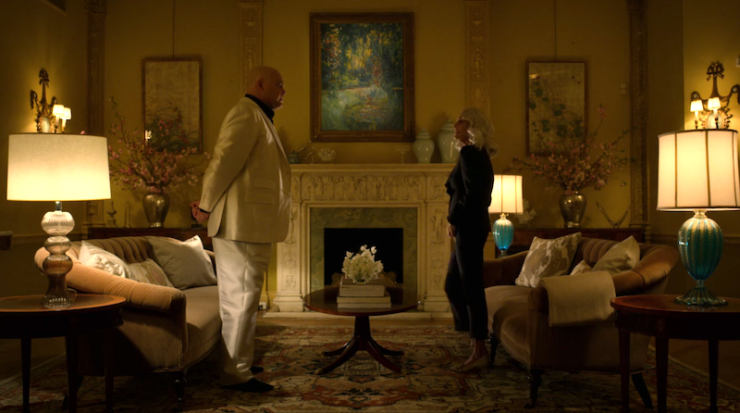
But Wilson Fisk does not understand art. And so it never occurs to him that this painting, despite the money that bought it, was never for him and cannot be appreciated to its full extent by him.
Esther Falb tells him about the night that this painting was taken from her family. It was 1943, and the Gestapo came to her family’s door and took all of their possessions. Her father tried to fight them off, and they killed him for it. She lost the majority of her family in the Holocaust, and this painting is all she has left. And what’s more, she knows that he is no different from the people who destroyed her world:
“This painting is my connection to the people I love. I know who you are, Mr. Fisk. You are a wolf, too. Men like you took away family, took away my ability to love, and almost took my life. You will take nothing more.”
Wilson Fisk listens to her, and tells her that he believes that Vanessa would want her to keep the painting. Esther Falb doesn’t know why that should matter to her, but Fisk explains, “it matters to me.” Even in this moment of seeming kindness, of comprehension, he doesn’t leave the painting with the woman who it rightfully belongs to because he understands that her connection to this piece of art is more profound than his. He leaves it with her because he thinks it’s what Vanessa would deem correct. He still has no opinions of his own.
This bears out in every artistic decision that Wilson Fisk is called on to make. The first dance song at his and Vanessa’s wedding seems just as likely to have been chosen by their band conductor as anyone—“The Look of Love” is a perfectly fine selection to dance to, but do either Fisk or Vanessa strike anyone as Burt Bacharach or Dusty Springfield fans? Fisk can’t even select the flower to put hin is lapel before they say their vows. He waffles in a minor panic until Vanessa chooses for him.
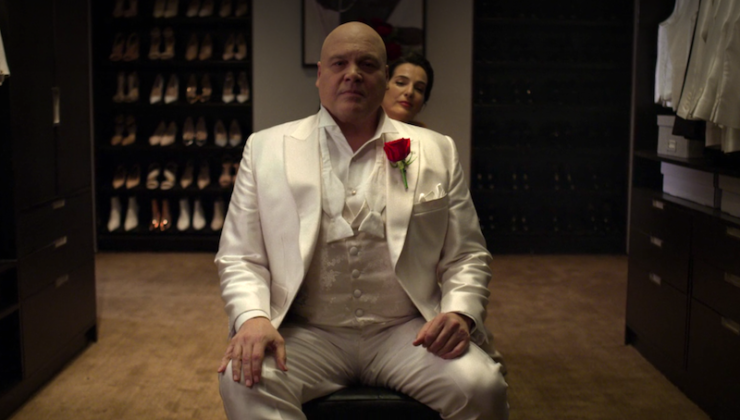
But it gets worse. Ben Poindexter, otherwise known as Bullseye, notes that Fisk does not retrieve the painting from Ms. Falb. Desperate to make himself indispensable to Kingpin—to become “another Wesley”—Dex murders Esther Falb and takes the painting back to the penthouse. It is clear that Vanessa knows Dex killed the woman for it, but as she never learns about the conversation Fisk had with Ms. Falb, she doesn’t see a problem in it. There is too much happening for Fisk to question its sudden appearance, either. Spiritually, this seems the greatest injustice of the entire series; a fascist (because Wilson Fisk is emphatically a fascist) given a piece of artwork that belonged to a family destroyed by the Nazis. It’s horrifying. It cannot stand. Someone has to fix this.
Good thing we’ve got Daredevil on our side.
When Matt Murdock confronts Wilson Fisk with the intent of killing him, the surroundings matter less than the end result. After a wedding reception interruption by Agent Nadeem’s death confessional, followed by Bullseye’s party crash, Daredevil and Kingpin retreat to the penthouse and have their showdown. In a flurry of action, while the duo have to contend with Dex and work to keep Vanessa safe, they beat each other relentlessly. Matt finally gets the upper hand and punches Fisk repeatedly in the face, an act of righteous fury and pain and catharsis—
—and he sprays Fisk’s blood across “Rabbit in a Snowstorm.”
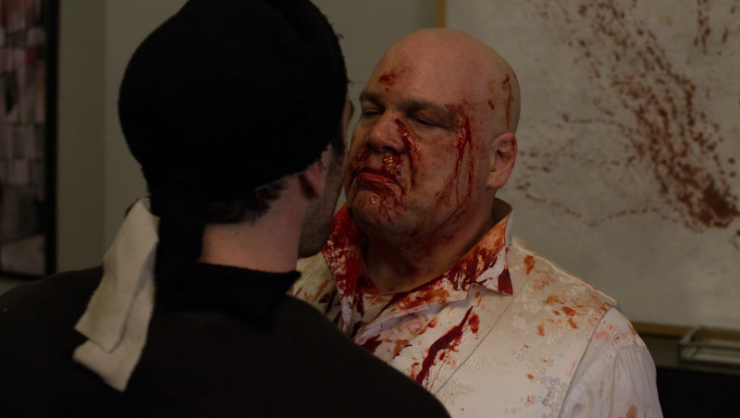
If it can’t belong to Esther Falb, then it certainly can’t default to a man the likes of Wilson Fisk. This painting, representative of the family it once belonged to, of history that we seem culturally ever-inclined to forget, cannot belong to a man who has never managed to cultivate an attachment to any form of art beyond its association with his wife. Because Ms. Falb is right; Wilson Fisk is a monster. This is a part of his monstrosity. He sees all art as a prop for stature and a signal of might to the outside world. He is emotionally incapable of forming a connection to any of it because he lacks basic empathy toward all but one or two people in the entire world. And that is where our creativity, our imaginations, our ability to engage with art comes from—empathy.
Art is incomprehensible to Wilson Fisk. So it seems only right that the devil should take it from him by coating the only work of art he deemed valuable in his own blood. It is not a coincidence that this is where their fight ends; Vanessa asks Daredevil to relent, and Matt Murdock returns to himself and makes the choice to spare Fisk’s life. Kingpin is stopped, and vengeance is won. The painting is no longer “peaceful,” as Fisk suggested when he came to talk to Ms. Falb—now it is a canvas of gradient white interrupted by violence and fear, his own blood a representation of the moment when Daredevil emerged victorious and the city was finally rid of him. The one piece of art that he chose to place genuine importance on is forcibly excised from him as a symbol of his defeat.
While there are many aspects of Wilson Fisk that make his villainy clear, Daredevil’s choice to focus on his separation from art is a signal for the viewer’s benefit. Fascism and a love of art seldom go hand-in-hand because art is a key avenue to speaking truth. But Kingpins aren’t interested in truth. They are interested only in possessing whatever they touch.
Emmet Asher-Perrin assumes that the government will repossess the painting… but you never know. You can bug him on Twitter and Tumblr, and read more of her work here and elsewhere.










